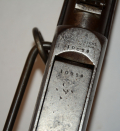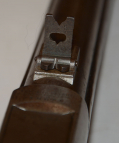site search
online catalog
SCARCE CONFEDERATE USED, C.S. ORDNANCE “CLEANED AND REPAIRED” FOURTH MODEL BURNSIDE CARBINE

$3,250.00
Quantity Available: 1
Item Code: 490-7048
Shipping: Determined by Method & Location of buyer
To Order:
Call 717-334-0347,
Fax 717-334-5016, or E-mail
This Burnside carbine shows it saw some heavy service and on the bottom of the stock bears a “Q” final inspection stamp of the Confederate Cleaning and Recovery (“C&R”) service. The particular inspector has not been identified, but the mark seems to be one applied as it passed out of the Richmond Arsenal/ Artillery Workshop on the way to reissue to a Confederate soldier. See Steven W. Knot, “’Captured and Collected’ Confederate Reissued Firearms” for details on these arms and markings. According to Knott’s research CS Ordnance teams, aided by some civilians, gathered some 200,000 firearms from battlefields during the war, mostly in the eastern theatre, where Lee’s victories left them in possession of the field, and another 50,000 or so were turned in by CS units. These went largely to CS facilities at Danville, Staunton, Lynchburg, and Richmond. Confederate inspection marks applied to these guns before reissue were at first thought to be inspector’s initials, but are now taken more to be letter and symbol stamps used by specific inspectors, but not necessarily corresponding to an inspector’s initial. Knot illustrates a Fifth Model Burnside also with a Q marking on pages 74-75, noting its placement, as here, on the buttstock behind the triggerguard tang, rather than forward of the triggeruard tang, as was possible on rifles and muskets. He also notes breechloading carbines are uncommon with these markings because cavalry engagements yielded few guns to capture and Confederate authorities in 1864 offered a very high $75.00 to civilian scavengers of battlefields for each breech-loading carbine turned in.
The carbine is a standard US cavalry issue 4th Model Burnside, serial numbered 10026 on both the top of the receiver and the breechblock. This places it toward the tail end of the Fourth Model, which was sequentially numbered following the Third Model, starting about #4100, with some overlap following, to about #11400, with an estimated 7,300 produced, followed by the Fifth Model (with its noticeable guide screw in the side of the frame, about April 1863. That would date this one to the first quarter of 1863, likely March.
The carbines rates about Very Good for overall condition with no original finish to speak of, but complete, all original and good markings, though the wood would rate under that for its handling dings, shallow divots, carved initials, etc. Front and rear sights are complete at present, as is the sling ring and bar on the left of the receiver for the carbine sling as well as the sling swivel the buttstock for the earlier shoulder sling that would loop through that and buckle around the barrel. The metal is smooth. The barrel and barrel band show a mottled thin brown mixed with gray, though the rear sight leaf shows some thin blue. The receiver is gray. The front of the receiver is clearly marked, “BURNSIDE PATENT / MARCH 25th 1856” with the serial number 10026 stamped immediately under that and matched by the number on the top front of the breechblock, with some light dings just below it. The rear of the lock plate is crisply marked “BURNSIDE RIFLE CO. / PROVIDENCE=R.I.”
The wood is a dark brown, matching on both buttstock and forestock, with a good fit to the metal though we note some chipping around the rear of the lockplate. The left wrist preserves a partially visible US inspection cartouche. The carbine also shows signs of active service, with a good number of dings, shallow divots and scratches on the buttstock, on the underside near the toe of the buttplate and at the left wrist for instance, with a small chip near the buttplate tang, and a deeper divot on side of forestock near the barrel band. Several initials are also carved or scratched in the stocks, a large “FM” on the right buttflat seems matched by an “F” on the forestock. We see an “H” lightly scratched near the cartouche on the left wrist, and a cruder, deeper “S” just aft of that. Still, for a Confederate-used gun, this is not bad. We also note some slight, very minute pitting, under the hammer and near the nipple, often a diagnostic of Confederate firearms fired with imported British “high-pressure” percussion caps, whose greater explosive power were the subject of some complaints in the British service, causing them eventually to be withdrawn.
The bore is semi-bright good rifling; slightly dusty but no visible pitting. Holds at half cock and full cock, but the half cock safely function does not work.
All in all, this Burnside with its Q-marking, Confederate use, and signs of extensive service in the field is to be appreciated for its rarity and character rather than on an abstract scale of condition. This would make a great addition to a Confederate cavalry collection. [sr][ph:L]
DISCLAIMER: All firearms are sold as collector's items only - we do not accept responsibility as to the shooting safety or reliability of any antique firearm. All firearms are described as accurately as possible, given the restraints of a catalog listing length. We want satisfied customers & often "under" describe the weapons. Any city or state regulations regarding owning antique firearms are the responsibility of the purchaser. All firearms are "mechanically perfect" unless noted, but again, are NOT warranted as safe to fire!
~~~~~~~~~~~~~~~~~~~~~~~~~~~~~~~~~~~
THIS ITEM, AS WITH ALL OTHER ITEMS AVAILABLE ON OUR WEB SITE,
MAY BE PURCHASED THROUGH OUR LAYAWAY PROGRAM.
CLICK HERE FOR OUR POLICIES AND TERMS.
THANK YOU!
Inquire About SCARCE CONFEDERATE USED, C.S. ORDNANCE “CLEANED AND REPAIRED” FOURTH MODEL BURNSIDE CARBINE
For inquiries, please email us at [email protected]
Most Popular
Historical Firearms Stolen From The National Civil War Museum In Harrisburg, Pa »
Theft From Gravesite Of Gen. John Reynolds »
Selection Of Unframed Prints By Don Troiani »
Fine Condition Brass Infantry Bugle Insignia »
British Imported, Confederate Used Bayonet »
Scarce New Model 1865 Sharps Still In Percussion Near Factory New »
featured item
CONFEDERATE CAVALRY SABER BY FROELICH
This is a very early and possibly unique Confederate cavalry saber, possibly even a cavalry officer’s saber, by Louis Froelich. It uses a crudely cast, heavy, thick guard, with the side branches branching off from the knucklebow at two different… (870-614). Learn More »
site search
Upcoming Events
May 16 - 18: N-SSA Spring Nationals, Fort Shenandoah, Winchester, VA Learn More »























